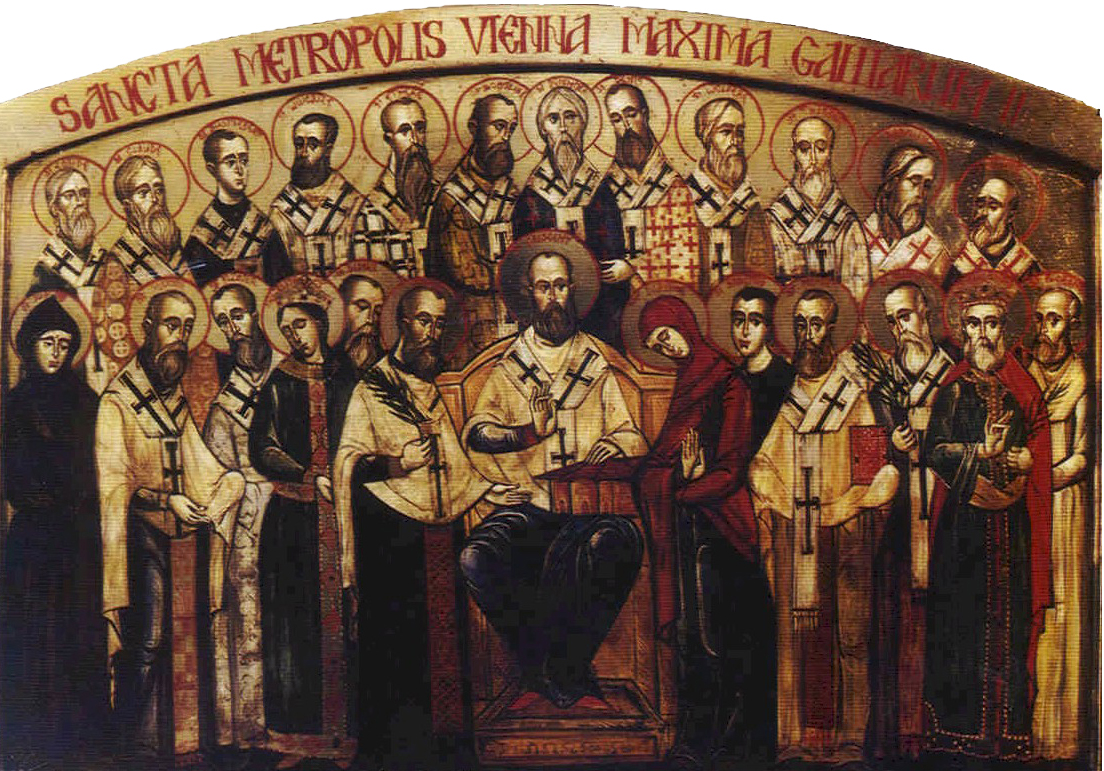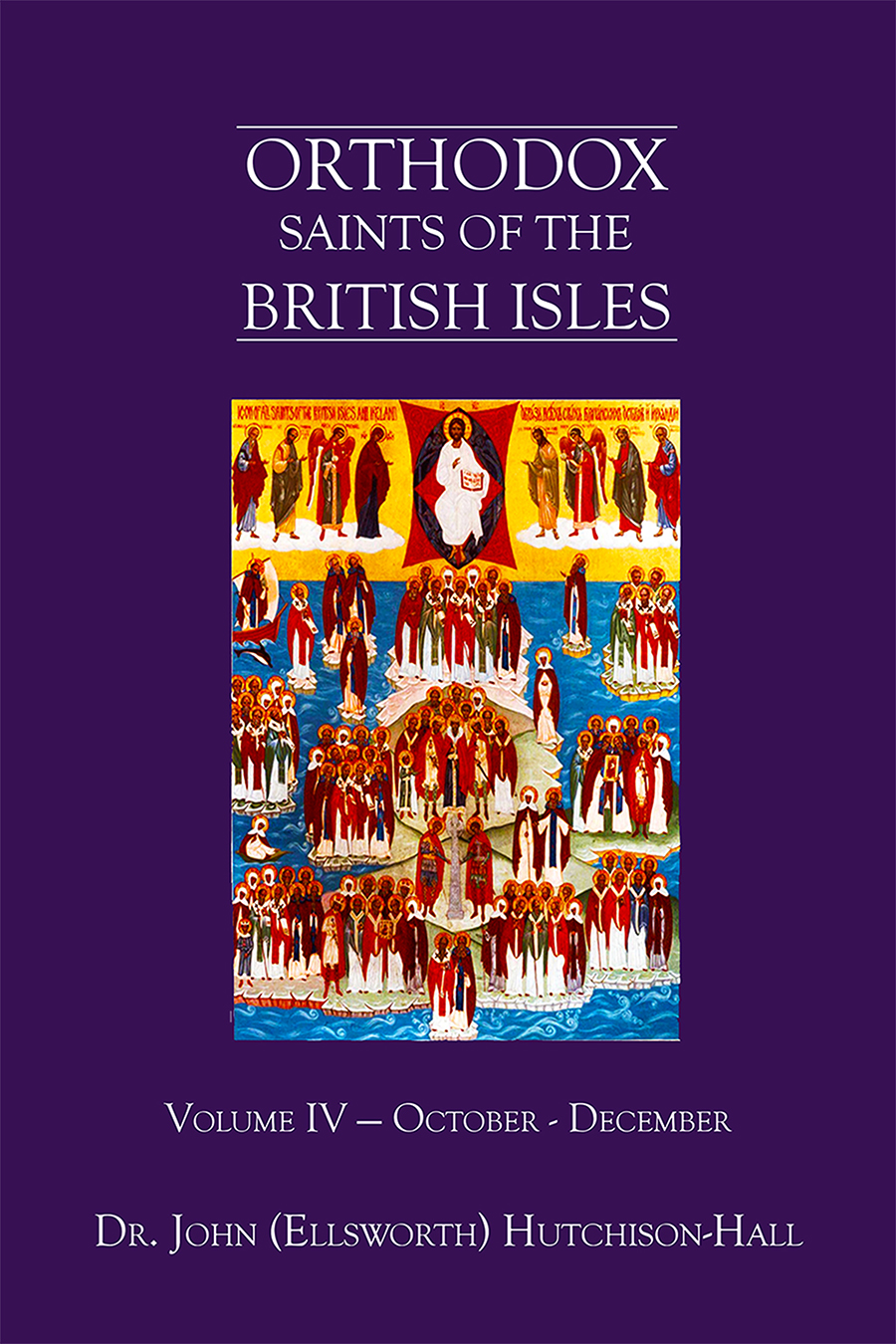
Orthodox Saints of the Pre-Schism
See of Rome
24th October (NS) — 11th October (OS) 2024
ÆTHELBURH (ETHELBURGH, ETHELBURGA) of BARKING, an East Anglian Princess who followed her brother St. Erconwald of London (30th April) into monastic life and served as the first abbess of the double monastery at Barking, Essex. St. Bede the Venerable (25th May) writes of many miracles which took place at Barking during her time as Abbess. Shortly before St. Æthelburh’s repose, St. Thorgyth of Barking (26th January) had a vision in which she saw a body wrapped in a shroud, shining with a bright light. As she watched, the body was drawn up to Heaven on cords which were brighter than gold. A few days later St. Æthelburh fell asleep in the Lord (circa 676).
AGILBERT (AGLIBERT) of PARIS, a Frankish aristocrat who began his ecclesiastical career at the Abbey of Our Lady of Jouarre (abbaye Notre-Dame de Jouarre) in Jouarre (north-central France). According to St. Bede the Venerable (25th May) St. Agilbert was consecrated bishop without a See before leaving for Ireland where he seems to have spent some time studying. In 650 he was invited by Cenwalh, King of Wessex (r. c. 642–672) to succeed St. Birinus of Dorchester (3rd December) as the second Bishop of Wessex, with his See centred at Dorchester-on-Thames (Oxfordshire). Disputes with the King over the territory of his See and St. Agilbert’s limited command of the local tongue led him to flee north it would appear to Northumbria. There he is said to have ordained St. Wilfrid of York (12th October) to the priesthood at Ripon (North Yorkshire) and accompanied St. Wilfrid to the Synod of Whitby (664), where they advocated for the adoption of Roman practices vide (Paschal Controversy). Not long after the Synod, St. Agilbert returned to Gaul where he took part in the episcopal consecration of St. Wilfrid, and soon was elevated to the See of Paris (circa 666–668) St. Agilbert served as Bishop of Paris until his repose circa 679–690, and was buried in the crypt at Jouarre Abbey.
ANSILIO, (Seventh Century), a monk at the Abbey of St. Peter (abbaye Saint-Pierre de Lagny) in present-day Lagny-sur-Marne (about 28km / 17mi east of Paris). Nothing further seems to be known of him.
BRUNO the GREAT, The youngest son of Henry I the Fowler, King of East Francia (r. 919–936) and St. Matilda of Saxony (14th March), and brother of Otto I the Great, Holy Roman Emperor (r. 936–973). St. Bruno served as Abbot of Imperial Abbey of Lorsch (Reichsabtei Lorsch) in the present-day German state of Hesse, and the Princely Abbey of Corvey (Fürststift Corvey) in the present-day German state of North Rhine-Westphalia, where he restored monastic discipline before he was consecrated Archbishop of Cologne (North Rhine-Westphalia) in 953. Soon after was made Duke of Lorraine by Otto. St. Bruno was a zealous pastor whose episcopate marked a new age in the city’s growth — spiritually, scholarly, and physically; many of the next generation of German ecclesiastical leaders were educated at St. Bruno's court, and he not only extended the then cathedral to the point where it was said to rival St. Peter's in Rome, he built churches and founded the Abbey of St. Pantaleon (Abtei St. Pantaleon) at Cologne. St. Bruno reposed in 965 whilst on a mission to Reims (north-eastern France), and was buried at St. Pantaleon's Abbey.
CANICE (CAINNECH, KENNETH) of AGHABOE, most of what we know of St. Canice is based upon legend. However, it is possible to glean a few facts from the Vita Columbæ by St. Adomnán of Iona (23rd September) in which he makes multiple references to St. Canice. St. Canice was born in present-day Co. Londonderry, Northern Ireland, and went to Clonard Abbey (Co. Meath, Ireland) to study under the great ‘Teacher of the Irish western-saints’ St. Finian of Clonard (12th December), with the group that came to be known as the ‘Twelve Apostles of Ireland’. He then went on the study under St. Mobhi of Glasnevin (12th October) at Glasnevin Abbey in present-day Co. Dublin, Ireland. When plague forced that community to disperse, St. Canice went to Wales to be a monk at Llancarfan under St. Cadog of Llancarfan (24th January). In time, St. Canice went north to assist in the evangelisation of the Scots. In Scotland he built the first church in what is now St. Andrews, and earned such respect amongst the Scots that he is one of the three favourite Irish saints in Scotland (along with SS. Bridget of Ireland (1st February) and Columba of Iona (9th June). St. Canice the returned to Ireland where he founded several monasteries on lands granted to him by the local king. His primary establishment was the Abbey of Aghaboe (in present-day Co. Laois) of which he served as Abbot. Towards the end of his life St. Canice wrote a commentary on the Gospels, which came to be known as the Glas-Chainnigh or Chain of Cainnech. St. Canice reposed and was buried at Aghaboe, towards the end of the sixth century at the age of eighty-four. He is the patron saint of Kilkenny, Co. Kilkenny, Ireland.
EMILIAN of RENNES, (Date Unknown), according to pre-2001 editions of the Roman Martyrology St. Emilian was a hermit at Rennes Brittany (north-western France), however, there is no local record of his existence.
EUFRIDUS, a seventh century monk near Asti in Piedmont (north-western Italy), whose relics were enshrined in the Cathedral of St. Lawrence (Cattedrale di San Lorenzo) in Alba also in Piedmont. Nothing further is known of his life.
FIRMINUS (FIRMIN) of UZÈS, a native of Narbonne in southern Gaul (France). Educated by his uncle Roricius, the third Bishop of Uzès (southern France), St. Firminus served as fourth Bishop of Uzès, from 538 until his repose in 553. His relics are enshrined at the Cathedral of St. Theodore of Uzès (Cathédrale Saint-Théodorit d'Uzès).
GERMANUS of BESANÇON, (Fourth Century), an early Bishop of Besançon (eastern France), there are no reliable details of his life extant, but it appears certain that he was martyred by heretics (probably Arians) towards the end of the fourth century.
GRATUS (GRAT) of OLORON, the first Bishop of Oloron in Aquitaine (south-western France), it is believed he took part in the Council of Agde (southern France) in 506, and reposed later that year.
GUMMARUS (GOMER), a son of the Lord of Emblem (near present-day Lier in northern Belgium), member of the court of Pepin the Short, King of the Franks (r. 751–768), and later a soldier. St. Gummarus married a young noblewoman who proved to be a cruel and capricious harridan who was abusive to servants and tenants. This behaviour weighed heavily on the deeply devout St. Gummarus, and in time he and his wife separated. St. Gummarus became a hermit at Nivesdonck, and soon attracted disciples. The area around his hermitage grew into present-day northern Belgium town of Lier. St. Gummarus reposed circa 774.
JULIANA of PAVILLY, a servant girl who received monastic tonsure at Pavilly Abbey in Normandy (north-western France), where she was a spiritual child of the Abbess, Benedicta. Upon Benedicta’s repose, St. Juliana was unanimously chosen to be the Abbess. St. Juliana reposed circa 750.
PLACIDIA, there is no verifiable information on St. Placidia extant, however according to tradition she was a monastic who lived in Verona (northern Italy) in the mid-fifth century, reposing circa 460.
Get your copy of Orthodox Saints of the British Isles today.
Available at Amazon or your favourite e-bookstore.
CADFARCH, reputed to have been a member of a family of unspecified saints, St. Cadfarch was a sixth century disciple of St. Illtyd (6th November). He is believed to have founded a church in Penegoes, Powys, Wales, where there is a holy well known as St. Cadfarch’s Well, said to have healing properties.
Troparion of St. Cadfarch
Tone VIII
Brother and companion of saints,
O Father Cadfarch, thou art truly numbered
among the Righteous of the Age of Saints.
Wherefore intercede for us, weak as we are,
that Christ our God will grant us great mercy.
EVERGISLUS (EBREGESILUS) of COLOGNE, an early fifth-century Bishop of Cologne in the present-day German state of North Rhine-Westphalia. St. Evergislus was martyred by bandits whilst visiting Tongeren in present-day Belgium.
FELIX (AFRICANUS) of THIBIUCA, AUDACTUS (ADAUCTUS) of THIBIUCA, JANUARIUS of THIBIUCA, FORTUNATUS of THIBIUCA, and SEPTIMUS of THIBIUCA, early victims of the Diocletianic Persecution (303–313). St. Felix, Bishop of Thibiuca in Africa Proconsularis, despite every enticement, refused to surrender Sacred Scriptures to the authorities. As a result, he along with Audactus, Januarius, Fortunatus, and Septimus, were martyred.
FROMUNDUS (FRÉMOND) of COUTANCES, Bishop of Coutances in Normandy (north-western France) from circa 674 until his repose circa 690. Whilst bishop, St. Fromundus founded the women's Abbey of the Our Lady of Ham (abbaye Notre-Dame de Ham) in Ham, in Normandy (north-western France).
MAGLORIUS (MAELOR) of WALES, a native of south Wales and possible relation of St. Samson of Dol (28th July), whom he accompanied to Brittany (north-western France). In Brittany they both became abbots, St. Samson at Dol, St. Maglorius at Lanmeur. Following the repose of St. Samson, St. Maglorius was appointed to succeed him as Bishop of Dol. Later he retired from his See, and went to Sark in the Channel Islands, there he founded a monastery where he lived until his repose circa 575. Later the relics of St. Maglorius were enshrined at the Église Saint-Jacques-du-Haut-Pas in Paris' 5th Arrondissement.
MARCIUS (MARK, MARTIN) of MONTE CASSINO, a hermit at Monte Cassino, whose virtues were acclaimed by St. Gregory the Dialogist (3rd September), and was said to have been a wonderworker by the twelfth century librarian, chronicler, and hagiographer of the Abbey of Monte Cassino Peter the Deacon (†c. 1153). Towards the end of his life St. Marcius left Monte Cassino and spent the rest of his life as a hermit in a cave on Mount Mondragone (southern Italy), where he reposed circa 679.
MARTIN of VERTOU, ordained to the Deaconate, or possibly Priesthood, by St. Felix of Nantes (7th July), St. Martin was noted for being a wonderworker, as well as, being devoid of any skill as a preacher. He founded a hermitage at Vertou south-east of Nantes (Upper Brittany, western France), in time the number of disciples who gathered around St. Martin necessitated founding what came to be the Abbey of St. Martin of Vertou (abbaye Saint-Martin de Vertou), serving as its first Abbot. St. Martin reposed in 601.
Prior to the Schism the Patriarchate of Rome was Orthodox, and fully in communion with the Orthodox Church. As Saint John of Shanghai and San Francisco +1966 said “The West was Orthodox for a thousand years, and her venerable Liturgy is far older than any of her heresies”.
Details of British Saints excerpted from Orthodox Saints of the British Isles.
Details of continental saints from these sources.
In many cases there are several spelling versions of the names of saints from the British Isles. I use the Oxford Dictionary of National Biography version as the primary version with the more prevalent version in parenthesis e.g. Ceadda (Chad) of Lichfield.

